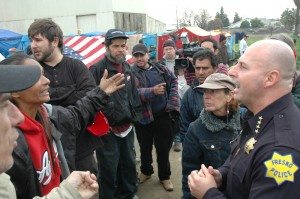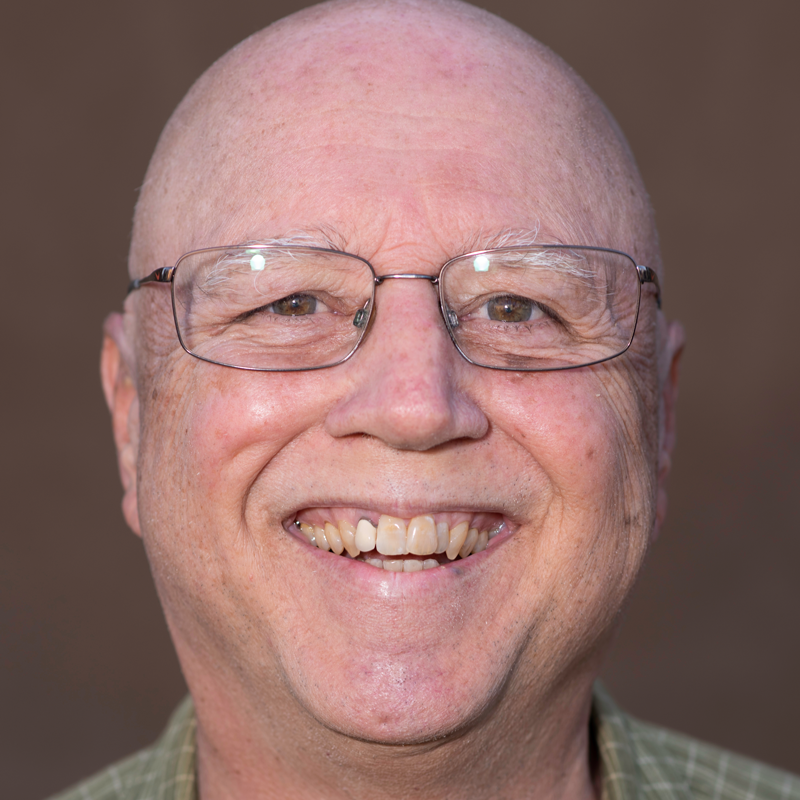
By: Mike Rhodes
The City of Fresno has been hammering away at the homeless, but not making much progress in the effort to end homelessness. On January 28, about 100 homeless people were evicted from an encampment on Ventura and F Street, a vacant lot that was owned in part by Tom Richards, a developer who was the chairperson of the city’s commission that wrote the Ten-Year Plan to End Chronic Homelessness.
The eviction was notable for the resistance of the residents who formed a line at the perimeter of the property and refused to leave. They demanded to know where they could move to, where they would not be threatened with eviction and legal action. They were finally convinced to leave by Police Chief Jerry Dyer who told them that “we are not going to stop you from going to another place
right now.”
Someone in the crowd said, “But you will just move us again, right?” Another voice in the group said, “That is a question we will ask later.” Dyer said, “That is right, that is exactly right.”
The problem was that the word later was not clarified. The homeless thought Dyer had promised them that they would be safe if they just moved to another vacant lot, as long as it was not the one on Ventura and F. They packed up their tents and belongings and moved to Mona and G Street, about a block away. They were soon told (within hours) to move again because the property owner did not want them there. What the homeless were not told was that the property owner at that location was the City of Fresno.
The nomadic group of homeless men, women, and children then moved to a plot of land the city had bought several years ago to build a campground for the homeless. The vacant lot, in the old industrial section of downtown Fresno, was never used for that purpose because the business owners complained and the homeless thought the property was too remote and rundown. Once again, the police told the homeless that they could not set up their tents on city property. They were told that the only place they could go and not be harassed was a strip of land at California and G Street named “Crack Hill.”
The police evicted the homeless from three different vacant lots that day and ultimately forced them to move to a known drug dealing location. The city will not provide the homeless with portable toilets, trash bins or drinking water, but they will pay lawyers to evict them from vacant lots, police to enforce the eviction, the installation of fences and sanitation workers to carry out the “cleanups.”
The following week, City Council member Larry Westerlund introduced an ordinance to stop homeless people from asking for help on the median islands. Bill Simon, the chairperson of the local American Civil Liberties Union, in response to these two events updated an old quote of Anatole France to read “The Law (and the City of Fresno), in its majestic equality, forbids the poor as well as the rich to sleep under bridges, to beg in the streets, and to steal bread. However, it prohibits only the poor to beg in the street-to the rich it issues permits.”
The Fresno City Council passed the ordinance with a 6-1 vote. Westerlund’s ordinance will remove homeless people from median islands while allowing established community groups to continue using the space for their fund-raisers.
Simon, speaking at the City Council meeting when the ordinance was proposed, said, “Perhaps Mr. Westerlund was well intentioned when he proposed this median safety ordinance, but on its face it has a discriminatory intent and motive against poor people, especially against the homeless, while protecting two popular fund-raisers-The Fresno Bee Day for Children’s Hospital and the firefighters fund-raiser. But the equal protection guaranteed by the Constitution does not allow one set of rules for some people and another set for others. Equal treatment means everyone or no one. If fund-raising on a median is unsafe for some, then it is unsafe for all.” Westerlund defended his ordinance, calling it a public safety measure and said it treats everyone equally. “Somebody who wanted to, up to one time every six months, would be able to come in and there would be a form they would fill out, a one-page form, it would be like here is my name, here is the median I would like to occupy on this date, whatever that date would be. We talked about a 48-hour notice before going out there,” Westerlund said.
The ordinance will require the applicant to pay a filing fee, provide proof of insurance and require the use of a brightly colored vest. Some proponents of the ordinance said it was strictly a safety issue and that it was not directed against the homeless.
But Ray Appleton, who had Westerlund on his KMJ radio show right after the ordinance passed, introduced the show by saying, “We are talking about the median island safety ordinance, which basically will kick the beggars off the median islands in Fresno, finally…It will take about 60 days to clear the legal hoops and after that they’re gone. Hallelujah!” Westerlund did not correct Appleton’s interpretation of the ordinance. Appleton went on to say that the homeless were “just an eyesore, to me it is as bad as litter, it is no different than litter on the streets, it is no different than paper in the gutters, garbage, it’s litter.”
Al Williams, a homeless man who says he uses the median islands to collect money, also spoke at the City Council meeting the day the ordinance was introduced. Williams said, “You all beg for money when you run for office. Each of you do. What makes you better than me? You know, you are a human being, just like a lot of the people out there are trying to make an honest dollar. Churches beg for money, Kids Day begs for money and the police department and the fire department beg for money, but you want to criminalize a poor person for asking for money. That is inhumane and
despicable.”
The City of Fresno, in collaboration with county, state and federal agencies could end homelessness almost immediately if it wanted to. All it would have to do is put those without a place to live into homes and apartments that have no people in them. There are more vacant houses, apartments and buildings in this town than there are homeless people. It is a stunning failure of the political and economic system that the city is unable to resolve this problem.
Studies show that it would be less expensive to provide the homeless with decent housing rather than attempting to solve the problem by passing “quality of life” ordinances against them, treating the homelessness as a police issue and chasing them from one vacant lot to another.
It would cost less than $30,000 a year to provide a homeless person with decent housing and the help he or she would need to get his/her life back on track. Because homeless people use the hospital emergency room as their primary care physician, policing costs and existing social services, we are already spending about $100,000 per year for each homeless person in Fresno. That $100,000 just maintains the broken system that currently exists.
We can end homelessness, improve people’s lives and save money if we established a Housing First model. Greg Barfield, the City of Fresno’s homeless czar, has given some homeless people housing vouchers. But those vouchers have gone to less than 200 of this city’s 15,000 homeless, and the vouchers come with significant restrictions. If the city was serious about ending homelessness, it would do the following:
* Immediately establish campgrounds around town that could accommodate everyone who is without housing. These facilities should be safe, pleasant, have drinking water, toilets and trash pickup. This needs to be done because even if the city implements a Housing First program tomorrow, it will take years to coordinate enough housing for every homeless person in Fresno.
* Provide Barfield with the resources he needs to fully implement a Housing First program.
* Start building abundant affordable housing in all parts of the community.
* Provide the homeless with whatever social services they need-job training, drug rehabilitation, mental health services, more education. Give them what they need to live happier and more productive lives.
Fresno can end homelessness, but doing so will require implementing the short-, medium- and long-term objectives above. If the city continues with its current course, you will see fingers pointing in all directions about why the first Ten-Year Plan to End Chronic Homelessness failed. You might even see Tom Richards, the developer who evicted the homeless from his vacant lot, chairing another city-funded commission to develop another Ten-Year Plan.
We don’t need another plan that enriches social service providers (the homeless call them poverty pimps) and government bureaucrats. What we need is a plan that ends homelessness. How do you end homelessness? You put homeless people in decent housing and provide them with the social services they need. It is that simple.
*****
Mike Rhodes is the editor of the Community Alliance newspaper.
E-mail him at editor@fresnoalliance.com.

